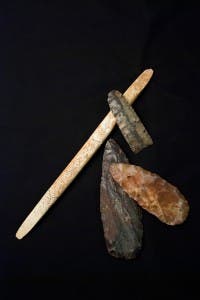The genome sequence of the Ice Age skeletal remains of a 1-year-old boy gave scientists tantalizing proof that the first settlers in North American originated in Asia, and not from Europe as some theories might suggest. The boy belong to a group of people known as the Clovis, the direct ancestors of modern day North American natives.
The remains of the Clovis child were first unearthed in 1968 near a rock cliff in Montana. At the burial site, thought to be some 12,600 years old, anthropologists also found 100 artifacts, including spear points and antler tools. In fact, the Clovis culture is widely known and recognized for its prolific use of tools. They’re the inventors of the the ‘Clovis point,’ a spear-shaped weapon made of stone that is found in Texas and other portions of the United States and northern Mexico. These weapons were used to hunt animals, including mammoths and mastodons, from 13,000 to 12,600 years ago.
Michael Waters, director of the Center for the Study of First Americans at Texas A&M, is part of the team that sequenced the genome of the skeleton remains. The analysis, by now standard, showed that the child and its forefathers no less, originated from Asia. This was widely considered of course, the leading theory being that ancient North American ancestors arrived at the continent by crossing a link between Asia and Alaska.
“We hope that this study leads to more cooperation between Native Americans and scientists. This is just one human genome. We need to know the genetic story of modern Native peoples and derive more genetic data from ancient remains to fully understand the origins and movements of the First Americans and their descendants,” Waters adds.
The Crow Tribe will oversee the the reburial of the remains in accordance with Native rituals in the near future, Waters also said.
“The genetic information provided by the Anzick boy is also part of the larger story of modern humans. We know that modern humans originated in Africa and then around 50,000 years ago spread rapidly over Europe and Asia. The last continent explored and settled by modern humans were the Americas. In essence, the Anzick boy tells us about the epic journey of our species,” he adds.
[source]










